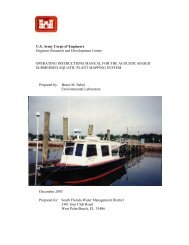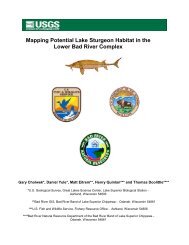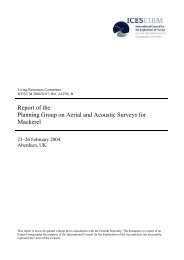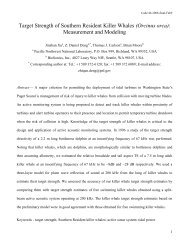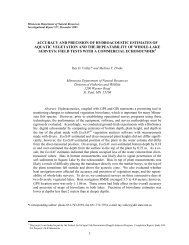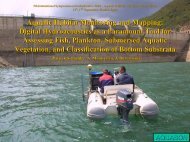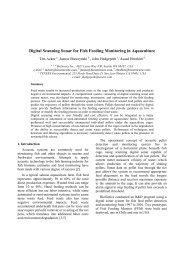Bottom Classification - BioSonics, Inc
Bottom Classification - BioSonics, Inc
Bottom Classification - BioSonics, Inc
You also want an ePaper? Increase the reach of your titles
YUMPU automatically turns print PDFs into web optimized ePapers that Google loves.
<strong>Bottom</strong> <strong>Classification</strong><br />
Janusz Burczynski,<br />
<strong>BioSonics</strong> <strong>Inc</strong>.<br />
CONTENTS<br />
1.INTRODUCTION<br />
2. METHODS OF BOTTOM CLASSIFICATION<br />
2.1. Averaging, Filtering and Clustering of Data<br />
2.2. First Echo Normalization (Cumulative Energy Curves).<br />
2.3. First/Second <strong>Bottom</strong> Ratio<br />
2.4. First Echo Division Method<br />
2.5. Fractal Dimension method<br />
2.6. Averaging and filtering of data<br />
2.7. Clustering of data using Fuzzy C-Means Clustering<br />
2.8. Sediments Layer<br />
2.9. Survey Maps<br />
3. REFERENCES<br />
APPENDIX: FRACTALS<br />
<strong>Bottom</strong> <strong>Classification</strong>6.doc page: 1
1. INTRODUCTION<br />
Before the invention of digital echosounders and processing methods, experienced fishermen were able to<br />
distinguish between a hard and soft bottom trace on an echosounder chart recorder.<br />
Figure 1. Example of hard and soft bottom traces on a black and white chart recorder.<br />
The information about bottom type, bottom sediments and aquatic plants is encoded in the echo signal. The<br />
signal can be stored and acquired simultaneously with GPS data. The echo signal can be decoded and<br />
information about the bottom can be projected onto a digital chart.<br />
In order to verify the results, either physical sampling of the bottom should occur or observation by divers or<br />
underwater camera should be recorded as acoustic data are acquired. Once verified, the results are saved so that<br />
unknown bottom types may be compared with this known and verified data set.<br />
The echo signal parameters depend on the type of bottom (in particular its hardness and roughness), but they<br />
also depend on the equipment parameters (i.e. frequency, transducer’s beamwidth and others). Therefore, the<br />
verified results will be valid only for the specific acoustic system that was used for verification.<br />
The methods of bottom classification implemented in <strong>BioSonics</strong> <strong>Bottom</strong> Classifier VBT are discussed in this<br />
paper. The objective is to help users to understand the physical principles of bottom classification methods<br />
implemented in the VBT software using a simple intuitive approach without using complex mathematics.<br />
<strong>Bottom</strong> <strong>Classification</strong>6.doc page: 2
2. METHODS OF BOTTOM CLASSIFICATION<br />
2.1. Averaging, Filtering and Clustering of data<br />
<strong>Bottom</strong> echo parameters vary widely from ping to ping. Because of this variability, we filter data and take an<br />
average value of bottom echo parameters over a number of pings.<br />
E 1<br />
E 1<br />
F D<br />
F D<br />
Figure 2. Example of data clusters for different bottom categories: E1 (first part of energy of first bottom echo)<br />
and FD (fractal dimension of echo envelope). Scatter plot of data shown on the left, data clusters with borders<br />
shown on the right.<br />
Echo signal parameters are displayed in x/y coordinates and bottom echoes are analyzed by clustering data that<br />
corresponds to different bottom categories (Figure 2). Clusters and cluster borders are computed for acoustic<br />
data files that are verified with physical observation of, bottom (ground truthed data). Then survey data for<br />
unknown bottom categories are classified according to the cluster rules; if a data report fits within a specific<br />
cluster border, then it is classified under this particular category (e.g. mud). If the data report does not fall<br />
within any of cluster borders, then the bottom is classified as unknown.<br />
Clusters can be computed in two or more dimensional space, however echo signal parameters x, y, z…etc.,<br />
should not be correlated.<br />
In the VBT software package, we classify bottoms using two parameters, but data are taken for more than two<br />
echo signal parameters.<br />
2.2. First Echo Normalization (Cumulative Energy Curves).<br />
One can expect that the hard bottom will produce a sharp bottom echo with high amplitude while a soft bottom<br />
will produce an elongated echo with lower amplitude. These phenomena can be observed on the oscilloscope<br />
and echogram of the echosounder when sampling hard and/or soft bottom during surveys.<br />
<strong>Bottom</strong> <strong>Classification</strong>6.doc page: 3
Figure 3. Different shapes for hard and soft bottom echo; a) Echo Signal amplitude and b) Cumulative energy<br />
curve.<br />
Figure 3 a) presents examples of echoes from both hard and soft bottom. Let us square the echo amplitude,<br />
integrate the echo amplitude squared and then make a cumulative curve of the bottom echo integral (see Figure<br />
3 b). There will be a different and distinct shape between cumulative energy curves of signals from hard and<br />
soft bottom. The hard bottom will produce a curve with a sharp increase while the soft bottom will produce a<br />
curve that increases with a relatively low slope. We can acquire the bottom echoes from a known bottom type<br />
and save the cumulative energy curves into a database. Then, for unknown bottom types we can implement the<br />
“curve fitness algorithm” and recognize the bottom type according to the shape of the cumulative energy curve.<br />
Pouliquen and Lourton (1992) developed this method of bottom classification. It is the B1 method implemented<br />
in the VBT software.<br />
2.3. First/Second <strong>Bottom</strong> Ratio<br />
Figure 4 presents simplified principles of the formation of the first bottom echo. Figure 5 shows the formation<br />
of the second bottom echo. Following Chivers (1990), we will introduce the “hardness” and “roughness”<br />
signature of the bottom echo and by estimating these signatures we will classify the bottom type.<br />
<strong>Bottom</strong> <strong>Classification</strong>6.doc page: 4
Figure 4. Formation of the first bottom echo.<br />
The initial part of the first bottom echo is caused by the first reflection off a surface perpendicular to the<br />
transducer axis. This part of an echo (specular and coherent) is very sensitive to the pitch and roll of the vessel<br />
and the transducer. The remainder of the first bottom echo is caused by an oblique back reflection (noncoherent)<br />
and is less sensitive to pitch and roll. The first bottom echo relates mainly to its roughness signature<br />
and the roughness of the seabed will be enhanced by the second part of the first bottom echo (oblique<br />
reflection).<br />
The second bottom echo is produced by a double specular reflection from the seabed and a single reflection<br />
from the surface of the water. For a flat bottom, the specular reflection will be directly related to the hardness of<br />
the bottom. The initial part of the second bottom echo will be enhanced by the hardness of the bottom. If the<br />
bottom is rough, then the roughness will have a diminishing effect on the second bottom echo. The second<br />
bottom echo will be carrying mainly the hardness signature with roughness diminishing it.<br />
Figure 5. Formation of the second bottom echo.<br />
<strong>Bottom</strong> <strong>Classification</strong>6.doc page: 5
<strong>Bottom</strong> scattering is a complex physical phenomenon. Movement of the vessel has an effect on the convolution<br />
of the transducer beam pattern function and the oblique back reflection function of the bottom. If we extract<br />
from the first and second bottom echo components of an echo signal related to the hardness and roughness of<br />
the seabed, then the clusters boundaries (rectangular fields) representing different bottom categories can be<br />
established in x/y coordinates (see Figure 6). The hardness signature is estimated by taking the integral of the<br />
echo envelope of the second bottom echo (E2) squared and the roughness signature is estimated by taking the<br />
integral of the second part of first bottom echo (E1).<br />
Figure 6. Projection of Hardness (E2) and Roughness (E1) signatures in the VBT software and classification<br />
fields (clusters) in x/y coordinates.<br />
This method of bottom classification using the first and second bottom echo energy integral was developed and<br />
published first by Orlowski (1984). Additional research was done by Chivers (1990). The method was<br />
commercialized first by Rox-Ann. This is the B2 method implemented in the VBT software.<br />
2.4. First Echo Division Method<br />
Hardness and roughness signatures can be extracted from the first bottom echo. The following are distinct<br />
phases of the bottom echo formation (see Figure 7):<br />
• Phase 1 - Attack - from the moment the pulse reaches the bottom until the time when the bottom is<br />
reached by the back slope of the pulse.<br />
• Phase 2 - Decay - from the end of the attack phase and lasting until the time when the front of the pulse<br />
reaches the boundary of the ideal beam pattern.<br />
• Phase 3 - Release - lasting until the time when the pulse completely enters the bottom.<br />
<strong>Bottom</strong> <strong>Classification</strong>6.doc page: 6
Phase 1<br />
Phase 2<br />
Phase 3<br />
Figure 7. Succeeding phases of the sounding pulse propagation for an ideal beam pattern.<br />
During Phase 1, the echo is caused by a surface reverberation; the reverberation area is circular with the<br />
diameter increasing with time (time equal approximately to pulse duration). Phase 2 includes both surface and<br />
volume reverberation. During Phase 3, the volume reverberation determines the bottom echo and the<br />
reverberation area has the shape of a doughnut.<br />
After the release phase is complete, in the case of an ideal beam pattern, the only source of the echo can be the<br />
reverberation due to bottom volume inhomogenity. This can be observed especially in the case of soft bottom<br />
types, for which the main part of the echo energy penetrates the bottom. The example in Figure 8 shows the<br />
model echo envelope generated by a soft bottom and Figure 9 shows the model echo envelope generated by<br />
different types of bottom (fine sand, sand, gravel and rock).<br />
0.003<br />
Is( t)<br />
Iv( t )<br />
Is( t)<br />
Iv( t)<br />
0.002<br />
0.001<br />
0<br />
67 68 69 70 71 72<br />
1000.<br />
t<br />
Figure 8. Results of echo envelope simulation for soft mud using an ideal (cone) beam pattern of 26° width.<br />
<strong>Bottom</strong> surface reverberation [Is(t)] is shown as a short dash, bottom volume reverberation [Iv(t)] as a long<br />
dash, and the sum [Is(t) + Iv(t)] as a line.<br />
<strong>Bottom</strong> <strong>Classification</strong>6.doc page: 7
0.008<br />
0.006<br />
0.004<br />
0.002<br />
0<br />
67 68 69 70 71 72<br />
1000 . t<br />
Figure 9. Results of echo envelope simulation for different types of bottom as measured by a 26° transducer:<br />
fine sand (line), sand (short dash), gravel (long dash) and rock (alternate long and short dash).<br />
The hardness signature is defined in the VBT software as the “energy of the first part of the first bottom echo”<br />
(E1), which lasts for the duration of the transmitted pulse. The roughness signature is defined as the energy of<br />
the “second part of the first bottom echo”, which is measured after the first part for a duration equal to 3 times<br />
the transmitted pulse width. The energy of the first and second part of the bottom echo is estimated by<br />
integrating the bottom echo amplitude squared.<br />
Figure 10. First bottom division method. Division of the first echo, and hardness (E1’) and roughness (E1)<br />
signature in x/y coordinates.<br />
Figure 10 shows the division of the first bottom echo (left side). The first part of the echo is represented by the<br />
unfilled portion of the envelope and the second part by the portion filled with diagonal lines. It also shows the<br />
hardness and roughness signature in x/y coordinates (right side): energy of the first part of the first bottom echo<br />
(E1’) and energy of the second part of the first bottom echo (E1). The different fields (rectangles) correspond to<br />
different bottom categories (mud, sand, and rock).<br />
This method of estimating roughness and hardness signatures using the first echo division is implemented in<br />
VBT as the B3 method.<br />
2.5. Fractal dimension method<br />
According to Euclidean geometry, a simple geometrical form can have dimension of 0 (zero: point), 1 (line), 2<br />
(surface), or 3 (volumetric geometrical figure). Geometric forms that display irregularities can be described as a<br />
form of fractal dimension objects (FD). By classifying the echo envelope in terms of its fractal dimension, we<br />
define the shape of the envelope by associating it with a FD number. Since the echo envelopes associated with<br />
different bottom types show regularities in shape, one can expect that we can classify the bottom echo in terms<br />
of FD.<br />
<strong>Bottom</strong> <strong>Classification</strong>6.doc page: 8
In the VBT software, the Fractal Dimension is a measure of the irregularity of an echo envelope obtained from<br />
the bottom. The echo is displayed in coordinates E1/FD (second part of first bottom energy versus Fractal<br />
Dimension). The fields for different bottom types are determined by means similar to the previous two methods<br />
(see Figure 11). This is the B4 method implemented in VBT.<br />
Figure 11. Fractal dimension method. The division of first bottom echo is shown on the left: the first part of the<br />
echo is represented by the portion of the envelope not filled and the second part by the envelope filled with<br />
diagonal lines. The Hardness signature and Fractal Dimension is displayed in x/y coordinates on the right (E1,<br />
energy of the first part of the bottom echo and FD, Fractal Dimension); three fields for different bottom<br />
categories are displayed (mud, sand, rock).<br />
2.6. Averaging and filtering of data<br />
The bottom echo displays a great deal of variability from ping to ping. In order to differentiate bottom echoes<br />
for different bottom categories we average a certain number of echo signals and produce a report from the<br />
averaged data (e.g. 20 pings averaged per one output report).<br />
The best bottom data are produced by a specular reflection from the bottom (perpendicular direction of<br />
transmission). A filter in the VBT software estimates energy per a specified number of pings. The strongest<br />
(highest energy) and weakest echoes are estimated for each report. It is assumed that an echo with the highest<br />
energy level is produced by specular reflection and is best for bottom classification, while the echo with the<br />
lowest energy level is produced by an oblique reflection and is worst for classification.<br />
A dialog box in the VBT filter allows the user to define the parameters for averaging and filtering the bottom<br />
echo signals with only higher energy levels. For example, the user may choose that only echoes with an energy<br />
level equal to or higher than 80% of the energy from the strongest echo will be used for data processing.<br />
2.7. Clustering of data using Fuzzy C-Means Clustering<br />
The VBT software version 1.5 includes the FCM (Fuzzy C-Mean Clustering) algorithm for automatic<br />
classification of fields for different bottom categories in x/y coordinates for methods B2, B3, B4.<br />
Fuzzy C-Means (FCM) is a data clustering technique wherein each data point belongs to a cluster to some<br />
degree that is specified by a membership grade. This technique was originally introduced by Jim Bezdek<br />
(1981) as an improvement on earlier clustering methods. It provides a method to group data points that populate<br />
some multidimensional space into a specific number of different clusters. The FCM algorithm starts with an<br />
initial guess for the cluster centers, which are intended to mark the mean location of each cluster. The initial<br />
guess for these cluster centers is most likely incorrect. Additionally, FCM assigns every data point a<br />
membership grade for each cluster. By iteratively updating the cluster centers and the membership grades for<br />
each data point, FCM iteratively moves the cluster centers to the “correct” location within a data set. This<br />
iteration is based on minimizing an objective function that represents the distance from any given data point to a<br />
<strong>Bottom</strong> <strong>Classification</strong>6.doc page: 9
cluster center weighted by that data point’s membership grade. Figure 12 shows clustering of Fractal Dimension<br />
data.<br />
Figure 12. Fuzzy C-Means Clustering technique for different bottom categories. Fractal Dimensions method B4<br />
for data files from VBT Catalogue: mud120.dt4, sand120.dt4 and rock 120.dt4.<br />
2.8. Sediments Layer<br />
A backtracking bottom tracking method is used in the VBT software. In this method, the software tracks the<br />
bottom from the far end of the received echo and moves towards a shorter range. Then, the bottom tracker locks<br />
to the rising edge of the first bottom echo. The sediment layer is located at the range above the bottom echo<br />
(i.e., it is the layer above the bottom). The sampling gate in VBT labeled “sediment layer” is open for sampling<br />
either sediment or bottom plant echoes. The VBT software estimates the thickness of this layer and the integral<br />
of the echo.<br />
2.9. Survey Maps<br />
Survey maps displaying the location of each VBT report acquired with GPS data can be displayed on the<br />
screen. Different bottom categories are color coded at the same time (see Figure 13). The output report of the<br />
VBT is produced in ASCII format. It provides the following information: date and time, report number, latitude,<br />
longitude, depth to the bottom, bottom category (coded as a number) and the energy estimated by calculating<br />
the integral of different parts of first and second bottom echoes.<br />
<strong>Bottom</strong> <strong>Classification</strong>6.doc page: 10
Figure 13. Survey map with different color-coded bottom categories estimated using Fractal Dimension<br />
method.<br />
REFERENCES<br />
Bezdek, J.C. 1981 Pattern Recognition with Fuzzy Objective Function Algorithms. Plenum Press, New York.<br />
Bakiera D. and Stepnowski A. 1996. Method of the sea bottom classification with a division of the first echo<br />
signal, Proceedings of the XIIIth Symposium on Hydroacoustics, Gdynia-Jurata, pp 55-60.<br />
Chivers R.C., Emerson N. and Burns D.R. 1990. New acoustic processing for underway surveying. The<br />
Hydrographic Journal, 56, 8-17.<br />
Mandelbrot, B. B. 1982. The fractal geometry of nature. Freeman, San Francisco.<br />
Orlowski, A. 1984. Application of multiple echo energy measurements for evaluation of sea bottom type.<br />
Ocenologia, 19, 61-78.<br />
Pouliquen E., and Lurton X. 1992. Sea-bed identification using echosounder signal. European Conference on<br />
Underwater Acoustics, Elsevier Applied Science, London and New York, p. 535.<br />
Stepnowski A., Moszyñski M., Komendarczyk R. and Burczyñski J. 1996. Visual real-time <strong>Bottom</strong> Typing<br />
System (VBTS) and neural networks experiment for seabed classification, Proceedings of the 3 rd<br />
European Conference on Underwater Acoustics, Heraklion, Crete, pp. 685-690.<br />
<strong>Bottom</strong> <strong>Classification</strong>6.doc page: 11
APPENDIX: FRACTALS<br />
http://library.thinkquest.org/12740/<br />
Classic geometry<br />
• We live in 3-dimensional space (width, length, and depth).<br />
• Plane (length and width) is 2-dimensional.<br />
• Line (length) is 1-dimensional.<br />
• Point is 0-dimensional.<br />
• We can visualize an object in each of those dimensions.<br />
Theoretical world of mathematicians<br />
• Mathematicians created 4 and more dimensional space, which is difficult to visualize.<br />
• Our universe can be presented as 4-dimensional space (3 geometrical dimensions & time).<br />
• If we can have n- dimensions (integers), why not fractals?<br />
Meaning of fractals<br />
• A defining property of fractals is self-similarity, or the repetition of patterns at all scales.<br />
• Another property that commonly exists in fractals is infinite complexity and detail.<br />
• The formal definition of fractals involves fractional dimension, which itself is somewhat complex.<br />
Example: Koch curve<br />
• Start with line.<br />
• Put a "kink" in the line segment, sort of making it more complex.<br />
• Put a "kink" in each line segment.<br />
• Continue this to get the Koch curve.<br />
• Kinks cause the line segment to grow towards becoming a plane, since it is expanding "height-wise".<br />
• However, this curve is not 2-dimensional.<br />
• It's only FD = 1.2618.<br />
• It is more than 1-dimensional, but not quite 2-dimensional.<br />
<strong>Bottom</strong> <strong>Classification</strong>6.doc page: 12
<strong>Bottom</strong> <strong>Classification</strong>6.doc page: 13
Application of fractals<br />
• We can represent shape of complex curve as fractal (number).<br />
• For bottom classification we can measure shape of echo envelope as FD.<br />
<strong>Bottom</strong> <strong>Classification</strong>6.doc page: 14



